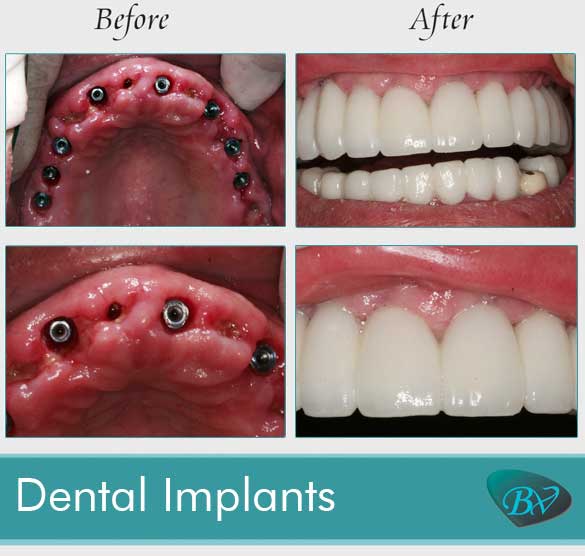How Dental Sense can Save You Time, Stress, and Money.
Wiki Article
The Facts About Dental Sense Uncovered
Table of ContentsDental Sense - An OverviewSome Known Incorrect Statements About Dental Sense Our Dental Sense IdeasThe smart Trick of Dental Sense That Nobody is Talking About
are clinical devices surgically dental implanted right into the jaw to restore a person's capability to chew or their appearance. They offer support for synthetic (phony) teeth, such as crowns, bridges, or dentures. When a tooth is lost as a result of injury or illness, a person can experience problems such as quick bone loss, faulty speech, or changes to eating patterns that lead to discomfort.Dental implant systems contain a dental implant body and dental implant abutment and may additionally consist of an abutment fixation screw. Dental veneers cost. The oral implant body is operatively placed in the jawbone in place of the tooth's origin. The dental implant joint is usually connected to the implant body by the abutment fixation screw and prolongs through periodontals right into the mouth to sustain the attached fabricated teeth
(http://www.place123.net/place/dental-sense-miami-united-states)Structure of The Oral Implant System choosing dental implants, speak with your oral company about the possible benefits and risks, and whether you are a candidate for the procedure. Points to take into consideration: Your overall health is an important consider identifying whether you are an excellent prospect for oral implants, for how long it will certainly take to recover, and for how long the dental implant may remain in area.
Smoking cigarettes might impact the healing procedure and lower the long-term success of the dental implant. The recovery process for the implant body may take a number of months or longer, throughout which time you generally have a short-term abutment instead of the tooth. the oral implant procedure: Carefully comply with the dental hygiene instructions provided to you by your dental provider.
Dental Sense Things To Know Before You Get This
Implant failing can lead to the need for one more operation to take care of or replace the dental implant system. Restores the capability to chew Brings back cosmetic look Helps keep the jawbone from reducing because of bone loss Protects the health of the surrounding bone and gum tissues Aids maintain surrounding (nearby) teeth stable Enhances lifestyle Damage to surrounding natural teeth throughout implant placement Injury to the surrounding tissues during surgical treatment, such as sinus opening Injury during surgical procedure (for instance, fracture of bordering jawbone) Poor feature, such as feeling like the teeth do not attack with each other usually An experience that the tooth is loose or twisting in position resulting from an abutment screw loosening up Implant body failing (looseness of the dental implant body) because of systemic infection, which may be most likely in people with uncontrolled diabetes mellitus because of regional infection in bone and gums sustaining the implant body as a result of postponed recovery, which might be more probable in people who smoke Problem cleansing the periodontals around the implant, leading to inadequate oral health Unattended periodontal illness Post-surgical pins and needles as a result of nerve impingement or damages Always notify healthcare providers and imaging service technicians that you have dental implants prior to any magnetic resonance imaging (MRI) or x-ray treatments.FDA is not familiar with any type of adverse events reported for MRI or x-ray procedures with oral implants. Oral implants systems are commonly constructed from products that adhere to international consensus criteria of the International Organization for Standardization (ISO) or ASTM International. These criteria have information of what makes a safe product.

A dental implant is a structure that changes a missing tooth. With screw-like tools, the cosmetic surgeon inserts an implant into the jawbone, and it serves as a support for a man-made tooth, called a crown. A device called an abutment connects the fabricated tooth to the dental implant. The crown is customized to fit the person's mouth and match the color of their teeth.
All About Dental Sense
Some people are not eligible for oral implant surgical treatment. It is for oral surgeons to operate individuals with: severe illnessuncontrollable metabolic diseasebone or soft tissue condition or infectionIf these problems are resolved, a person can have the surgery. In, oral doctors avoid operating individuals with: If individuals with any one of the above undergo oral implant surgery, there is a higher threat of the implant stopping working.
Dental dental implant surgical procedure is a customized process. Offer you time to heal. Affix the message and last crown, bridge or denture.
Next off, your surgeon will meticulously position the dental implant right into your jaw. If your implant is near the front of your mouth, your dental professional will make a short-term tooth for you to put on up until you heal.
The Best Strategy To Use For Dental Sense
Your provider can inform you what to anticipate in your scenario. Throughout the recovery phase, your jawbone needs to fuse to the oral implant. This procedure, called osseointegration, is essential for security and lasting success. This process can take anywhere from three to nine months. In some cases, it might take longer.When your implant heals, your Your Domain Name dentist can attach the joint (small connector post) and your final restoration (crown, bridge or denture). This typically takes regarding one hour to finish and might call for a 2nd small surgical treatment. You should not really feel any type of discomfort throughout your dental implant treatment because your supplier will certainly utilize medication to numb your periodontals.
Report this wiki page